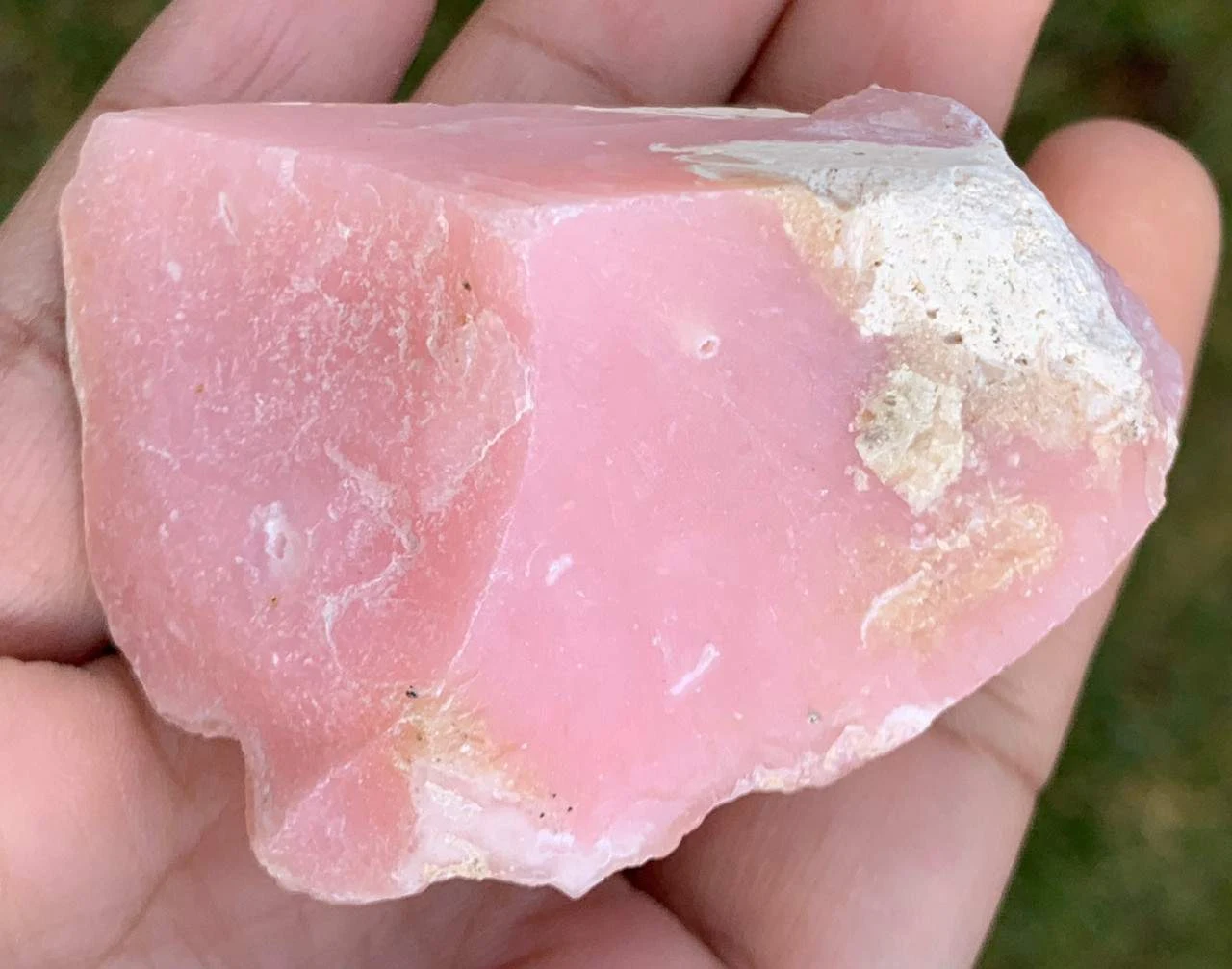Pink Opal: Properties, Occurrence
Pink opal is a type of opal gemstone characterized by its delicate pink coloration. It is a relatively rare and highly valued variety of common opal. Its pink coloration is typically due to the presence of trace amounts of manganese within its structure.
Pink opal belongs to the common opal category, meaning it doesn't exhibit the vibrant 'play-of-color' seen in precious opals like black opal. However, similar to fire opal, which is primarily valued for its vivid body color, pink opal is appreciated for its soft hues. Pink opal color can range from a soft bubblegum pink to a subtle pinky-white. Some specimens may have hints of orange or peach.
Pink Opal Formation: Like other types of opals, pink opal often forms in voids and cavities within rocks. The silica-rich water that percolates through these spaces can deposit tiny spheres of silica gel, which then solidify to form opal. Over time, these deposits can accumulate and result in the formation of pink opal.
 |
| Australian Pink Opal. Photo: Outbackmining.com |
Pink Opal Properties
Composition: SiO₂ (amorphous silicon dioxide) with trace impurities of iron (Fe³⁺) and other transition metals. It belongs to the mineraloid class due to its non-crystalline structure.
Color: Pink opal exhibits a range of pastel shades, from pale lavender to bubblegum pink, often with subtle variations within the stone.
Translucency: Pink opal can be translucent to opaque, depending on the density and distribution of its internal inclusions. Gem-quality stones are typically translucent, allowing light to pass through and enhance the stone's color.
Hardness: With a Mohs hardness of 5.5-6.5, pink opal is relatively durable for everyday wear. However, it is still susceptible to scratches and fractures, requiring careful handling and proper storage.
Luster: Pink opal exhibits a vitreous to waxy luster, depending on the presence and type of inclusions. Gem-quality stones tend to have a smooth, vitreous luster, while those with more inclusions may exhibit a waxy or greasy appearance.
Fracture: Pink opal has a conchoidal fracture, meaning it breaks with smooth, curved surfaces. This characteristic can be helpful for identifying genuine stones from imitations.
Inclusions: Pink opal often contains inclusions of other minerals, such as palygorskite and chalcedony. These inclusions can add texture and visual interest to the stone, contributing to its unique character.
Crystal Form: Typically massive, druzy, or botryoidal. Can also occur in nodules or veins.
Fluorescence: Weak to moderate yellow or orange fluorescence under longwave ultraviolet light.
Pleochroism: Weak, with some stones showing a slight shift in color depending on viewing direction.
Heat Sensitivity: Pink opal can fade and lose its color if heated too much.
 |
| Natural Pink Opal Rough Stones from Peru |
Where is pink opal found
While pink opal can be found in a few locations around the globe, its primary sources are concentrated in specific regions:
Main Sources:
- Peru: Considered the primary source of the most coveted, vividly colored pink opals. The Acari Mine in the Arequipa region is particularly renowned for its high-quality stones.
- Mexico: Deposits located in Durango and Chihuahua states yield beautiful pink opals, often with a slightly peachy or orange hue compared to Peruvian stones.
Other Sources:
- Australia: Smaller deposits in Western Australia produce pink opal, typically characterized by a more opaque, milky appearance due to its composition as opalized radiolarite.
- United States: Limited deposits occur in Idaho and Oregon, offering pink opal with unique characteristics depending on the specific location.
 |
| Polished Pink Opal |
Uses and Applications of Pink Opal
Pink opal, with its delicate beauty and versatile properties, finds application in various realms beyond mere adornment. Here's a breakdown of its diverse uses:
Jewelry
Popular Gemstone: Pink opal is a captivating choice for rings, necklaces, earrings, and pendants, often set in silver or gold for a touch of elegance and femininity. Its pastel hues complement various styles and add a unique charm to any outfit.
Cabochons and Carvings: Skilled artisans craft stunning cabochons and carvings from pink opal, highlighting its natural beauty and color variations. These can be incorporated into pendants, bracelets, or even statement pieces like brooches.
 |
| Pink Opal Cabochon |
Decorative Objects
Elegant Accents: Pink opal adds a touch of sophistication and whimsy to decorative objects like sculptures, figurines, and ornamental bowls. Its gentle colors and smooth texture create a sense of tranquility and natural beauty in any space.
Inlays and Mosaics: Pink opal can be incorporated into intricate inlays and mosaics, adding a unique color palette and texture to furniture, walls, or even art pieces. This skilled craftsmanship showcases the stone's versatility and artistic potential.
Metaphysical and Healing Practices
Stone of Love and Peace: Many cultures associate pink opal with love, gentleness, and emotional healing. It's believed to promote self-love, compassion, and inner peace, making it a popular choice for meditation and spiritual practices.
Aura Cleansing and Protection: Some believe pink opal can cleanse negative energy and aura imbalances, offering protection and emotional well-being. While these beliefs lack scientific evidence, they hold cultural significance and contribute to the gemstone's allure.
 |
| Pink Opal from Peru |
Pink opal, with its distinctive pastel hues and lack of play of color, presents a unique and captivating gemstone experience. Understanding its formation, composition, and physical properties allows for a deeper appreciation of its beauty and role in the world of gemstones.
Read also:
Hyalite Opal - Formation, Properties, Uses
Matrix Opal - Formation, Appearance & Types of Matrix Opal








